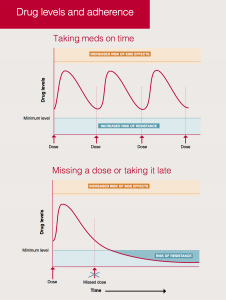Drug adherence in detail
 How much adherence is enough?
How much adherence is enough?
- Adherence refers to taking medicines as prescribed.
- This includes getting the right dose, at the right time, plus following any other advice, such as taking with or without food.
- When ART was first available, adherence needed to be very high – routinely taking 95% or more doses.
- Now that ART involves fewer pills and fewer doses, adherence is also easier. Although perfect adherence is ideal, occasional missed doses are okay.
- Most people living with HIV are pretty good at taking meds. Adherence to ART is higher than for many other medicines. But if you are having trouble, please talk to your doctor. They can only help if they know about any problems.
Window periods for different drugs
 These graphs show an average way to describe drug absorption and adherence.
These graphs show an average way to describe drug absorption and adherence.
- Drugs are usually absorbed quickly to reach the maximum concentration (Cmax). Levels then fall until the time for the next dose (Cmin or Ctrough)
- It is good to aim for the same time each day, but an hour or two either side is also okay for all ARVs. A routine will help with remembering.
- Actual drug levels will be higher for some people and lower for others, but these just need to be within a target range. Drugs that leave the body more slowly allow more flexibility with late or missed doses.
- For example, efavirenz, emtricitabine and tenofovir (TDF) all have long half-lives. This combination (these meds are combined in Atripla) is easier if you sometimes miss doses.
- By comparison, the NNRTI rilpivirine has a shorter half-life and leaves the body more quickly. Even when rilpivirine is used with TDF and emtricitabine (in Eviplera/Complera), adherence needs to be more exact.
- With long-acting injections like cabotegravir-LA and rilpivirine-LA given every 8 weeks, each injection needs can be given between every 7 to 9 weeks.
Differences between people
- Although some drugs have different doses based on body weight, most HIV drugs use a standard dose for adults.
- Dosing for children is more difficult and is often worked out by age or in relation to height and weight.
- Some HIV meds need the dose to be adjusted with reduced liver or kidney function.
- Doses are sometimes increased if you have drug resistance.
How important is food advice?
- Some meds need to be taken with food (mainly boosted protease inhibitors or boosted integrase inhibitors). The food is needed for the drugs to get to effective drug levels. Sometimes forgetting the food is like only taking half a dose.
- The type of food can also sometimes be important.
- Some drugs needs a certain number of calories. For example, rilpivirine needs at least 400 to 500 calories. For others, any amount of food is okay to help absorption. Sometimes this is because food changes stomach acidity levels.
- Sometimes avoiding food is to stop high drug levels. For example, efavirenz should not be taken close to a high fat meal as fat increases drug absorption and this increases side effects.
What about drug interactions?
- Information about drug interactions is important to mention in this section because it is related to the way your body processes drugs.
- For example, drugs that are mainly processed by the liver do this using liver enzymes. Other drugs can affect the levels of these enzymes, which in turn will affect the level of HIV meds.
- For example, if another drug increases the level of these enzymes, the HIV drugs will be cleared more quickly and drug levels will be too low.
- If another drug reduces the levels of these enzymes, the HIV drugs will stay around for longer and drug levels will be too high.
- A similar process happens for drugs that are processed by the kidneys.
Drug interactions
Drug interactions can occur with:
- Other HIV drugs.
- Other medicines (including ones sold without a prescription).
- Over-the-counter meds like antacids.
- Herbs and supplements.
- Multivitamins (i.e. with integrase inhibitors).
The best online HIV resource for checking drug-to-drug interactions is:
www.hiv-druginteractions.org
This website is in both English and Spanish. It also includes information about drugs to treat hepatitis C, COVID and gender affirming hormones.
Last updated: 1 January 2025.
